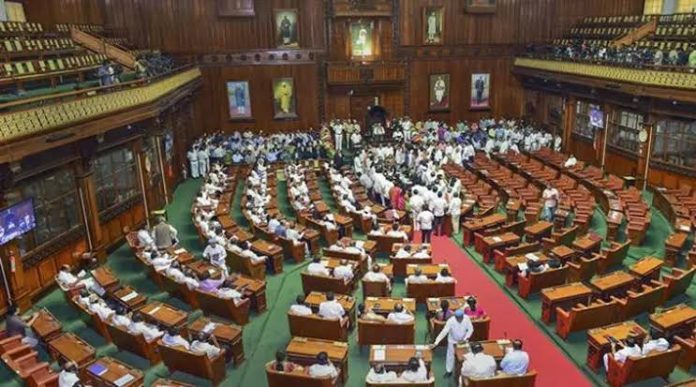This article is authored by Akash Krishnan, a student from ICFAI Law School Hyderabad. It discusses in detail the provisions regarding the formation and abolishment of State Legislative Councils.
Table of Contents
Introduction
India follows a bicameral system, i.e., a system wherein a state has two legislative bodies. In India, the Parliament is divided into two houses, i.e., the Lok Sabha and the Rajya Sabha. Similarly, the state governments also have an option to follow the bicameral system and establish two legislative bodies namely the State Legislative Assembly and the State Legislative Council.
Each state has to mandatorily form a State Legislative Assembly and this body acts as the lower house of a state legislature. On the other hand, the state is empowered to create a second legislative body, i.e., the State Legislative Council of its own volition. The state is also empowered to abolish this body. The State Legislative Council, if any, acts as the upper house of a state legislature.
Currently, six Indian States have Legislative Councils. The same has been enumerated below:
- Andhra Pradesh Legislative Council
- Bihar Legislative Council
- Karnataka Legislative Council
- Maharashtra Legislative Council
- Telangana Legislative Council
- Uttar Pradesh Legislative Council
State Legislative Council
The State Legislative Council acts as the upper house of a state legislature. It is also known as the Vidhan Sabha or the House of Review. Article 169 of the Constitution of India empowers a state to institute or abolish a State Legislative Council. Members of the State Legislative Assembly are directly elected by the people of the state whereas members of the legislative council are nominated by the State’s Governor or are elected through indirect elections.
Composition and election of the members of the State Legislative Council
Article 171 of the Constitution of India lays down the composition of a State Legislative Council. It states that the total number of members in the State Legislative Council shall not be more than 1/3rd of the total number of members in the State Legislative Assembly. Also, the total number of members in the Legislative Council should not be less than 40.
Until the Parliament provides the composition of the State Legislative Council, the members of the State Legislative Council are either nominated by the Governor or are elected indirectly by the State Legislative Assembly. The composition of the members of the State Legislative Council is as follows:
- 1/3rd members of the State Legislative Council shall be elected by the members of the local bodies such as municipal bodies, district boards or other local bodies specified by the Parliament.
- 1/12th of members of the State Legislative Council shall be elected by graduates.
- 1/12th of members of the State Legislative Council shall be elected by the teachers.
- 1/3rd of members of the State Legislative Council shall be elected by the State Legislative Assembly members. If any member of the State Legislative Assembly is elected during this process, their membership in the Assembly will cease to exist.
- The remaining members of the State Legislative Council shall be nominated by the Governor. The members of the State Legislative Council nominated by the Governor should have knowledge or expertise in any of the following areas, i.e., science, arts, social service, cooperative movement, or literature.
Article 172(2) of the Constitution of India lays down the term of office for the members of the State Legislative Council. It states that 1/3rd of members of the State Legislative Council shall retire on expiry of every 2 years.
Abolition of State Legislative Councils
Article 169 of the Constitution of India states that, on the passing of a resolution by the State Legislative Assembly of a state, the Parliament by law can provide for the creation or abolition of the State Legislative Council. The resolution should be voted by at least 2/3rd majority members who are present and voting. The process of abolition of a State Legislative Council is as follows:
- As per Article 168, a resolution shall be presented in the State Legislative Assembly for abolishing the existing State Legislative Council.
- The resolution for abolishing the existing State Legislative Council should be passed with 2/3rd majority members of the State Legislative Assembly.
- After the resolution is passed, the resolution for abolishing the State Legislative Council is presented in the Parliament.
- If both the house of the Parliament and the President of India give assent for the abolition of the State Legislative Council, then the State Legislative Council shall be abolished.
States that have abolished their State Legislative Councils
As of now, 8 Indian States have abolished their State Legislative Councils owing to several different reasons. Let us now discuss this in detail.
Assam Legislative Council
Assam Legislature was unicameral and had a legislative assembly from 1913 to 1935. The Assam Legislative Council was introduced in 1935 through the Government of India Act, 1935 and Assam became a bicameral legislature. The Assam State Legislative Council was dissolved by the India (Provincial Legislatures) Order, 1947.
Bombay Legislative Council
The Bombay Legislative Council was set up under the Indian Councils Act, 1861 and it acted as an advisory body to the British Administration. The Bombay Legislative Council provided advice and assistance in the Bombay provincial region. It had a strength of 20 members by 1892.
With the advent of the Indian Council Act 1909, the strength of the Bombay State Legislative Council increased to 40 members including the Governor. With the enactment of the Government of India Act 1935, Bombay Province was turned into a bicameral legislature where the Bombay State Legislative Council became a permanent body.
In 1960, the Bombay Province was bifurcated into Maharashtra and Gujarat which resulted in the abolition of the Bombay Legislative Council under the Bombay State Reorganisation Act, 1960.
Jammu and Kashmir Legislative Council
The Jammu and Kashmir Legislative council or the Jammu and Kashmir Vidhan Parishad acted as the upper house for the former state of Jammu and Kashmir. The first State Legislative Council of Jammu and Kashmir was introduced by Maharaja Hari Singh in 1934. After independence, the State Legislative Council was established for the second time under the provisions of the Legislative Council Act 1957 thereby making Jammu and Kashmir a bicameral legislature. The Legislative Council of Jammu and Kashmir was abolished on October 16th, 2021 due to the reorganization of the State into two new territories. The State Legislative Council of Jammu and Kashmir was abolished through the provisions of the Jammu and Kashmir Reorganisation Act, 2019.
Punjab Legislative Council
The Punjab Legislative Council or the Punjab Vidhan Parishad was introduced in 1956. The State Legislative Council had a strength of 39 members and had its seat in Chandigarh. The Punjab Legislative council was abolished in 1969 by the Punjab Legislative Council (Abolition) Act, 1969.
Tamil Nadu State Legislative Council
The Tamil Nadu Legislative Council was an amended version of the Madras Legislative Council. The Madras Legislative Council was the first legislature of Madras Province. It was formed to act as an advisory body to the British Administration in the Madras Province. It was formed in 1861 under the Indian Council Act 1861.
After Independence, the Madras Legislative Council continued to be the upper house for the state of Madras. In 1969, Madras Legislative Council was renamed to Tamil Nadu Legislative Council after the State was renamed to Tamil Nadu from Madras.
The Tamil Nadu Legislative Council was abolished in 1986 by Tamil Nadu Legislative Council (Abolition) Act, 1986 that was passed by both houses of the Parliament and received the assent of the President on 30 August 1986. The Tamil Nadu Legislative Council was abolished due to the interference of defeated political leaders in the working of the State Legislative Council.
Andhra Pradesh Legislative Council
The Andhra Pradesh Legislative Council or the Andhra Pradesh Sasana Mandali acted as the upper house for the State of Andhra Pradesh. The Andhra Pradesh Legislative Council was formed in 1958 through a resolution passed by the Andhra Pradesh Legislative assembly in this regard. It was abolished in 1980 on the ground of being unnecessary, unrepresentative to the population of Andhra Pradesh, and a great burden to the Andhra Pradesh State Budget.
The Andhra Pradesh Legislative Council got its first revival in 1989 where the Resolution was passed in the Andhra Pradesh Legislative Assembly. The Resolution for the revival of the State Legislative Council was also passed in the Rajya Sabha but due to the dissolution of the Central government in 1991, the Resolution was not passed in the Lok Sabha. Again, a resolution was passed in the Andhra Pradesh Legislative Assembly for establishing the State Legislative Council in 2004. This was accepted by both the houses of the Parliament and the Resolution received presidential assent in 2007 thereby leading to the formation of the Andhra Pradesh Legislative Council.
A resolution for the abolishment of the Andhra Pradesh Legislative Council was passed by the Legislative Assembly in 2020. Currently, the matter is under consideration in the Parliament.
Criticism to the formation of State Legislative Councils
At times Indian political enthusiasts have heavily criticised the concept of the State Legislative Councils on the ground that they are a burden over the State Legislature. Some of the criticism has been enumerated below:
Redundancy
Most of the time, the majority party in the lower house has the maximum number of members in the State Legislative Council as well. This results in them forming a majority in the State Legislative Council which may further result in the superfluous working of the State Legislative Council as the legislation or bills introduced by the ruling party in the state will be passed in the State Legislative Council without any proper discussion. In a situation where the majority members of the State Legislative Council are from the opposition parties, they can cause undue delays in the passing of bills, thereby causing a deficiency in the effective functioning of the State Legislature.

Lacks efficiency
The State Legislative Council is vested with supervisory powers which are not complete in itself. The power vested in the State Legislative Council can easily be overrun by the State Legislative Assembly. For example, a bill is presented in the State Legislative Council for discussion. After discussion, the State Legislative Council makes some recommendations that are not accepted by the State Legislative Assembly. Even though the recommendations are not followed by the State Legislative Assembly, it can still pass the legislation after a period of four months. This indicates that the State Legislative Assembly can function in an arbitrary fashion.
Opportunity for defeated members
At times it is seen that the members of the State Legislative Council are those individuals who are defeated in the state elections and therefore fail to enter the State Legislative Assembly. The State Legislative Council helps these defeated members to continue their political careers by being a superfluous part of the legislature. This is the defeat of the very purpose of the State Legislative Council as the seats of the State Legislative Councils are occupied by such defeated members rather than graduates, experts, and teachers who can make suitable contributions to the legislation passed by the State Legislative Assembly.
Financial burden
It is to be noted that an additional house in the State Legislature will increase the expenditure of the state. The cost of maintaining and running the State Legislative Council is very high. Government has to spend money on the security, travel, stay, and all other expenses of the members which act as an extra financial burden on the part of the state.
Conclusion
It is clear that the State Government has the power to create or abolish a State Legislative Council under Article 169 by passing a resolution with a 2/3rd majority in the State Legislative Assembly. Thereafter, the resolution has to be passed in both the houses of the Parliament and presidential assent is required as a final confirmation. Most states have preferred the abolishment of their respective State Legislative Assemblies after their reorganisation. Tamil Nadu and Andhra Pradesh are the two states where the State Legislative Council was abolished due to criticism. In India, currently, 6 States have State Legislative Councils. Only time will tell as to how long these Councils will survive and whether other states will form bicameral legislatures in future.
References
- https://blog.forumias.com/answered-discuss-the-need-and-importance-of-legislative-councils-in-indian-states/
- https://www.drishtiias.com/daily-updates/daily-news-analysis/legislative-council-3
- https://www.constitutionofindia.net/constitution_of_india/the_states/articles/Article%20169
- https://indianexpress.com/article/explained/explained-madhya-pradesh-may-get-a-second-house-why-do-some-states-have-vidhan-parishads-5913149/
- https://www.lawyersupdate.co.in/constitution-of-india/article-169-abolition-or-creation-of-legislative-councils-in-states/
LawSikho has created a telegram group for exchanging legal knowledge, referrals and various opportunities. You can click on this link and join:
https://t.me/joinchat/L9vr7LmS9pJjYTQ9
Follow us on Instagram and subscribe to our YouTube channel for more amazing legal content.
 Serato DJ Crack 2025Serato DJ PRO Crack
Serato DJ Crack 2025Serato DJ PRO Crack









 Allow notifications
Allow notifications



